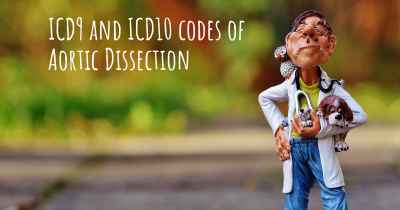How is Aortic Dissection diagnosed?
See how Aortic Dissection is diagnosed. Which specialists are essential to meet, what tests are needed and other useful information for the diagnosis of Aortic Dissection

How is Aortic Dissection diagnosed?
Aortic dissection is a life-threatening condition that occurs when there is a tear in the inner layer of the aorta, the large blood vessel that carries oxygenated blood from the heart to the rest of the body. Prompt diagnosis is crucial for effective treatment and improved patient outcomes. The diagnosis of aortic dissection involves a combination of clinical evaluation, imaging tests, and sometimes additional diagnostic procedures.
Clinical Evaluation:
The initial step in diagnosing aortic dissection involves a thorough clinical evaluation by a healthcare professional. The doctor will take a detailed medical history, including any risk factors or symptoms that the patient may be experiencing. They will also perform a physical examination, paying close attention to the patient's blood pressure, heart rate, and any abnormal sounds in the chest.
Imaging Tests:
Imaging tests play a crucial role in confirming the diagnosis of aortic dissection. The most commonly used imaging techniques include:
- Chest X-ray: A chest X-ray may be the first imaging test performed to evaluate the aorta and surrounding structures. While it may not directly visualize the dissection, it can provide important clues such as an abnormal aortic contour or signs of complications.
- Computed Tomography (CT) Scan: CT scan is the gold standard imaging modality for diagnosing aortic dissection. It provides detailed cross-sectional images of the aorta, allowing the doctor to visualize the tear and assess its extent. Contrast dye may be used to enhance the visibility of the blood vessels.
- Magnetic Resonance Imaging (MRI): MRI uses powerful magnets and radio waves to create detailed images of the aorta. It is particularly useful in cases where CT scan results are inconclusive or when there is a concern about radiation exposure.
- Transesophageal Echocardiography (TEE): TEE involves inserting a specialized probe into the esophagus to obtain high-resolution ultrasound images of the heart and aorta. It can provide real-time visualization of the dissection and is often used when urgent diagnosis is required.
Additional Diagnostic Procedures:
In some cases, additional diagnostic procedures may be necessary to confirm the diagnosis or assess the extent of the aortic dissection. These procedures may include:
- Aortic Angiography: Aortic angiography involves injecting a contrast dye into the blood vessels and taking X-ray images to visualize the aorta and its branches. It is an invasive procedure and is typically reserved for cases where other imaging tests are inconclusive.
- Blood Tests: Blood tests may be performed to assess the patient's overall health, including kidney function and markers of inflammation. These tests can help identify any underlying conditions that may have contributed to the development of aortic dissection.
Conclusion:
Diagnosing aortic dissection requires a combination of clinical evaluation and imaging tests. Prompt recognition and accurate diagnosis are essential for initiating appropriate treatment and preventing potentially life-threatening complications. If you suspect aortic dissection or experience symptoms such as severe chest or back pain, difficulty breathing, or fainting, it is crucial to seek immediate medical attention.
Posted Mar 29, 2017 by Timo Söderlund 6072
Posted May 20, 2017 by Karin 400
Posted Jul 12, 2017 by Errol 1650
Frequently used imaging procedures include:
1.Transesophageal echocardiogram (TEE). This test uses high-pitched sound waves to produce an image of the heart. ...
2.Computerized tomography (CT) scan. CT scanning generates X-rays to produce cross-sectional images of the body. ...
3.Magnetic resonance angiogram (MRA).
Posted Jul 19, 2017 by Rudesh 550
Dan Burgess UK
Posted Sep 11, 2017 by Dan 1998
Posted Sep 12, 2017 by Eduardo A V 100
or during an open surgery... ..There are numerous caused to AD as well, so They cane be caused BY out of control BP , genetics , Peripheral Artery or Vascular disease (PAD OR PVD), Trauma Car accidents or Motorcycles falls from horseback or HIGH falls anytime you have velocity and come to an abrupt stop the heart is suspended from the Aorta and Vena Cava Which can tear as it pendulums forward. also STress and strains , even (Syphilis) . Marfan's Lowey dietz and so on...
Posted Sep 22, 2017 by Jim 5641
The symptoms in my case were relatively mild and without knowledge of my father and uncles death I would not have been able to point the emergency doctors and cardiologists in the right direction and could have died.
Big hospitals have the best chance of detecting CAD as they have cardiologists on hand.
Posted Sep 23, 2017 by Christine 1400
.education of professionals and first responders is vital
Posted Feb 3, 2018 by Lindsay McKinney 2520
Posted Feb 4, 2018 by Julie 750
Posted Feb 10, 2018 by Marvinskan 1100
Posted Mar 2, 2018 by Mark 600
Posted Jun 3, 2018 by Jeppe 2300
Cardiologist, cardiovascular surgeon
Posted Jun 6, 2018 by Karhleenmc 800
Posted Sep 23, 2018 by Stefan 2500
Posted Nov 7, 2018 by Sean 900
Posted Mar 12, 2019 by Bengt 2500
Posted May 13, 2019 by Chris 1600
Posted Jul 20, 2019 by Sean 400
ULTRASOUND
GAMMA RAY SCAN
MRI SCAN
Posted Jul 29, 2019 by MCSzombie 6220
Posted Oct 9, 2019 by Sandy 2500
1. for an echocardiogram
2. Through Computerized Tomography
3. By MRI
The CT scan is the gold standard of the industry for diagnosing an aortic dissection.
Posted Jan 20, 2020 by Kurt 900
Posted May 26, 2020 by Arne 2300
Posted Apr 4, 2021 by Robert 9039
Posted Apr 2, 2022 by Larry 2550








